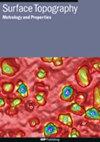Influence of contact angle on droplet parameters in ellipsoidal wettability model
IF 2
3区 材料科学
Q2 ENGINEERING, MECHANICAL
引用次数: 0
Abstract
Contact angle is one of the most important indexes to evaluate the hydrophobicity of solid surface. In order to explore the wetting characteristics of droplets on anisotropic solid surfaces, including contact angle, droplet radius, droplet height, contact radius, contact area and projected area, an ellipsoidal droplet contact angle model was established. Different from the ordinary plane ellipsoidal cap model, the major axis and minor axis of the elliptical cap shape in this model are not exactly the same in different planes. This model studied the relationship between contact angle and interface parameters in different planes. By collecting the droplet size parameters of fluororubber (FKM) prepared by template method, the correctness of the theoretical model was verified. Among them, the maximum error between the theoretical value of droplet radius and the actual measured value was 4.3%, and the maximum error of droplet projected area was 2.1%. It was found that the contact angle was inversely proportional to the droplet-solid contact radius and contact area, and directly proportional to the projected area of the droplet. In addition, for the same droplet on the surface of the same solid material, it was observed that the contact radius between the droplet and the solid was small in the direction of large contact angle. This discovery is helpful to explain the hydrophobic mechanism of the material surface with anisotropic contact angle.椭球润湿性模型中接触角对液滴参数的影响
接触角是评价固体表面疏水性的重要指标之一。为了探讨液滴在各向异性固体表面上的润湿特性,包括接触角、液滴半径、液滴高度、接触半径、接触面积和投影面积,建立了椭球状液滴接触角模型。与普通平面椭球帽模型不同,该模型中椭球帽形状的长、短轴在不同平面上并不完全相同。该模型研究了接触角与界面参数在不同平面上的关系。通过收集模板法制备的氟橡胶(FKM)的液滴尺寸参数,验证了理论模型的正确性。其中液滴半径理论值与实际测量值的最大误差为4.3%,液滴投影面积的最大误差为2.1%。结果表明,接触角与液滴-固体接触半径和接触面积成反比,与液滴投影面积成正比。此外,对于同一固体材料表面上的同一液滴,观察到在大接触角方向上,液滴与固体的接触半径较小。这一发现有助于解释具有各向异性接触角的材料表面的疏水机理。
本文章由计算机程序翻译,如有差异,请以英文原文为准。
求助全文
约1分钟内获得全文
求助全文
来源期刊

Surface Topography: Metrology and Properties
Materials Science-Materials Chemistry
CiteScore
4.10
自引率
22.20%
发文量
183
期刊介绍:
An international forum for academics, industrialists and engineers to publish the latest research in surface topography measurement and characterisation, instrumentation development and the properties of surfaces.
 求助内容:
求助内容: 应助结果提醒方式:
应助结果提醒方式:


